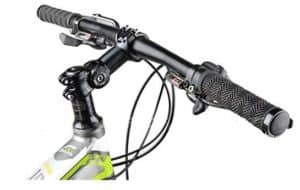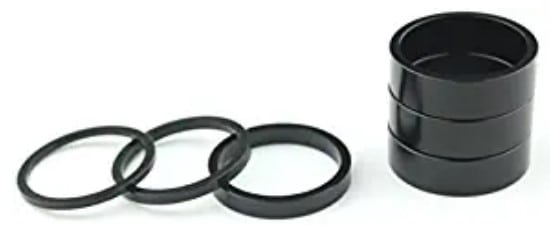Nearly 80% of mountain bikes have a threadless headset. Sadly, not all threadless stems come with the right elevation, resulting in backache, neck strain, and other issues. To avoid all that, let me summarize how to raise handlebars on mountain bike threadless below.
Generally, you can raise your threadless mountain bike headset by moving the headset spacers, adding a stem raiser (or extender), or switching to a riser bar. Alternatively, you can replace your existing bike stem with a more flexible option.
I’ll explain all four options in detail shortly. Hopefully, that’ll help you pick the ideal way of raising your MTB handlebar.
But first, let’s differentiate a threaded headset from a threadless option and understand why to consider raise handlebars.

Threadless Vs. Threaded Headset
As I mentioned, threadless headsets are found in almost 80% of mountain bikes. They feature a large top bolt and two smaller ones. That’s how you identify them.
As for threaded headsets, they are only available in not more than 20% of MTBs, mostly older designs.
You can identify a threaded headset by looking for a continuous metal that runs through the handlebar and one sizeable top bolt.
You won’t find the continuous running tube on a threadless headset.
Why Should You Raise Your Mountain Bike’s Handlebar?
Here are the primary reasons to consider mountain bike handlebar height extension:
- Alleviate lower back pain – When your bike handlebar is lower than the seat, you are likely to lean a lot, which strains your back. So, you may have to deal with constant lower back pain. Luckily, you can avoid it all by raising the handlebar by a few inches.
- Prevent neck pain – Just like a lower handlebar causes pain in your lower back, it also strains your neck, causing neck pain. So, raising the bar saves you from neck pain.
- Better road visibility – You are likely to lower your when cycling if the handlebar is lowly-positioned. In the long run, it becomes harder to see the road before you. Raising handlebars on mountain bike, fortunately, saves cyclists from that.
- Better navigation – When the handlebar is well-positioned, you get to navigate the bike better and more comfortably. You become more confident cycling.
- Reduced hand numbness – You are more likely to stain your hand when your handlebar is lower. Raising it by a couple of inches saves you from all that.
- Comfortable for growing kids – As kids outgrow a bike, they need a higher bike handlebar. If not, then they’ll strain to ride it.
4 Ways On How To Raise Handlebars On Mountain Bike Threadless
Here are four ways you can raise your MTB’s headset:
1. Add Headset Spacers
Though you won’t raise your MTB handlebar by a considerable margin, adding a few headset spacers can help you make it taller.
If you have no idea what spacers are, they are carbon or aluminum rings on the bike stem.
In general, removing your spacers lowers the bike stem, and adding them makes it taller. In our case, consider adding a few spacers to improve the mountain bike handlebar height.
Most bikes feature 20-30mm of spacers that you can move freely. And if you are looking for headset spacers, consider the ODIER Bike Headset Spacers, which come as a 6-piece set.
These aluminum alloy spacers are MTB and road bike compatible.

Overall, here are the steps for adding spacers:
- Loosen the bolts on the bike stem
- Detach the top cap from the bike stem
- Slide off the stem to remove it from the steerer tube
- Now add the spacers to raise the handlebar
- Then return the top cap as it was and screw it
2. Invest In A Stem Riser
You can also raise your handlebar by adding a stem riser or extender. Some threadless stem risers can raise your bike handlebar by about 5-6 inches, which is pretty impressive.
One top recommendation is the LERWAY Bike Stem Riser. It’s perfect for threadless MTB stems with a 28.6mm diameter.
The stem extender comes with an adjustable height that lets you raise your bike’s handlebar by up to 85mm. Included are four spacers that you can swap to raise or lower the bike’s handlebar.
You can follow these simple steps to install a stem riser and enjoy raised handle bars:
- Remove the bolt on the top cap and faceplate
- Lift the handlebar and then remove it completely
- Slide the stem extender into the steerer tube
- Reinstall the handlebar as it was before tightening the bolt
3. Replace the Bike Stem
If your existing stem is short, it makes sense to go for a more extended, adjustable option.
In most cases, you’ve to choose between an angled-stem and an adjustable-height bike stem.
Angled-stems only raise bicycle handlebar by a few inches. One such bike stem is the Wake MTB Mountain Bike Stem, which angles your bike handlebar between 0 degrees and 60 degrees.
The bike stem works on mountain bikes, BMXs, and road bikes. It’s compatible with a bike handlebar with a 31.8mm diameter.
Installing this angled-stem is easy as you only need to connect it to your front-fork stem.
As for the adjustable-height bike stem, you can count on it to raise your bike handlebar a little higher. One such bike stem is the Qikour 25.4 Adjustable Bike Stem.
The bike handlebars stem suits bike stems with a 28.6mm diameter and enjoys a 0-60 degrees adjustable angle.
4. Switch To A Riser Bar
Are you using a traditional MTB flat bar? Then it might be the perfect time to switch to a riser bar.
That’ll allow you to raise the handlebar by a few inches while not interfering with the bike’s navigation and style.
There are so many bicycle handlebar risers you can go for, but I recommend the RaceFace Atlas Mountain Bike Handlebar.
This riser bar offers you a 1.25-inch rise, which is not bad for a mountain bike handlebar. It comes in an air alloy construction to guarantee strength and lasting performance.
The handlebar is also ultra-wide and ultra-low to offer you optimal navigation comfort. It’s generally perfect for intense cycling.

FAQs On How To Raise Handlebars On Mountain Bike Threadless
1. How Do You Raise The Handlebar On A Threadless Stem?
You can raise the handlebar on a threadless stem using any of these approaches:
- Add more circular spacers
- Invest in a stem extender
- Swap your flat bar with a riser bar
- Replace your existing stem with an adjustable-height bike stem
2. How Do I Raise The Handlebar On My Mountain Bike?
Here’s a summary of how to raise mountain bike handlebars:
You can adjust your mountain bike’s handlebar by adding headset spacers or a stem riser. You can also do it by replacing your flat bar with a riser bar or changing the entire stem with a height-adjustable option.
3. Are Stem Risers Safe?
Yes, stem risers are very safe to install and use. They are easy to fit and work just fine, even if they raise your handlebar.
4. What Is The Correct Handlebar Height?
Essentially, the top of the bike’s handlebar should be 5-6cm below the saddle’s mid-point. That’s more important for a performance bike.
However, when it comes to fun road bikes, the handlebar should be at the same level as the saddle midpoint or just a few centimeters below it.
5. Should A Bike Seat Be Higher Than A Handlebar?
The rule of thumb is that the handlebar top should be as high as the bike seat or slightly higher. That’s unless you are a racer.
Relevant:
Closing Thought:
Now you know how to raise handlebars on mountain bike threadless. You can pick any of the four approaches and employ them. That’ll save you from back and neck pain and other issues.